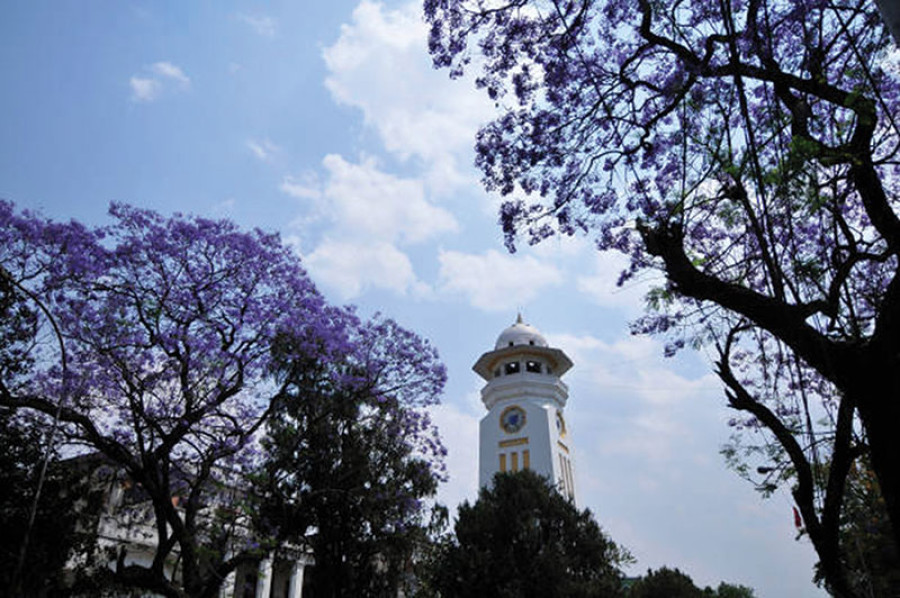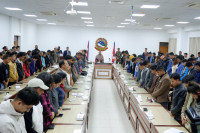Opinion
Valley of Jacarandas
Recently, I read an article about the worsening environment and health condition of Kathmanduites due to air pollution. That is true, each passing day the air quality of Kathmandu is deteriorating. The main cause is lack of greenery.
Motikala Subba Dewan
Recently, I read an article about the worsening environment and health condition of Kathmanduites due to air pollution. That is true, each passing day the air quality of Kathmandu is deteriorating. The main cause is lack of greenery. In the name of widening roads, most of the trees are cut down, and huge buildings and malls come up on open spaces. The water level is decreasing. One can see large potholes and tunnels everywhere in many parts of Kathmandu. When it rains, it is difficult to walk on the muddy street; and when it stops, the dust makes it hazardous to breathe besides making it hard to see. Road construction inside and outside Kathmandu is going on at a snail’s pace, making the situation more frustrating. Only in a few places do we have the privilege of witnessing greenery. The city looks suffocated.
The latest global Environmental Performance Index ranks Nepal at the bottom in terms of air quality among 180 countries besides highlighting air pollution as a leading threat to public health.
Flowers to the resque
A report in the journal Environmental Science & Technology published by the American Chemical Society says that green plants, trees, bushes and other greenery growing in the concrete-and-glass canyons of today’s cities can reduce nitrogen dioxide and microscopic particulate matter levels, both of which can be harmful to human health. They are found beyond safe levels on the streets of many cities. They are eight times more dangerous than other pollutants. One way of improving air quality in Kathmandu is cultivating trees and plants along the streets. In the name of growing plants, random planting may actually destroy the beauty of the city.
Reading about gulmohar trees and their flame-red and fragrant flowers in Kerala, India in Coconut Country Musings by Jacob C Varghese made me nostalgic about my home town Dharan where you can see orange/red gulmohars on the streets and in many houses. In most warm places in Nepal, one can see orange, red gulmohars and yellow, purple, blue and pink jacarandas/mimosas blooming at this time of the year. They bestow the feeling of a dreamland where nature is adorned in a flowery attire and is welcoming you. Can we not plant jacarandas on every corner of Kathmandu to improve the air quality in the city? They are drought tolerant, fast growing and wildlife friendly. They also provide shade and protect the sidewalk.
The jacaranda tree is also called the Hawaiian mimosa tree. It is grown from cuttings or grafting by seedling rootstock and normally takes two to three years to bloom. It blooms better after a cold dry winter and in warm weather, from late spring to early summer. The purple or blue flowers of the jacaranda last long. March and April are the best months to see blooming jacarandas in Nepal. Many countries in the world celebrate a special day for flowers. Japan is known around the world for its Cherry Blossom Festival. It is held all over Japan during the spring. That is the time when domestic and international visitors come and enjoy this popular flower festival. Australia celebrates the Jacaranda Festival.
Let it bloom
We are deeply connected to the environment we live in, and it is in our hands to keep it safe and clean. We must start planting jacarandas in the city to improve the air quality besides making it a destination for tourists. We can see pink mimosa (siris) blooming in the middle of the street in Baneshwor. We could plant jacarandas in Ratna Park, on the streets of Lazimpat, New Road, Ring Road and wherever space is available. Initiation can be seen on the streets of Naxal where there are growing lines of young purple jacaranda trees; some of them are already blooming. Once they are in full bloom, one can imagine how exotic the view will be in the area. If we start with this idea, we can celebrate a jacaranda festival in Nepal in the future and have blue and purple petals decorate our footpaths.
Pollution has become a major concern in the world today. Air pollution is a major environmental health problem affecting developing countries like Nepal. To improve the ambiance of Kathmandu, we have to start thinking from today. I would like to quote the chief of the Biodiversity and Environment Division Maheshwar Dhakal who said, “There is no alternative to trees, if we increase the greenery by 5 percent, it will improve the air quality in Kathmandu. There are nearly 5 million people in Kathmandu. For one person, more than six trees are needed. So we can imagine how many trees should be planted in Kathmandu!”
Let’s commit ourselves to improving the air quality in Kathmandu by planting jacarandas to create not only a healthy place but a beautiful home for the present and the future generations. We can start at home and then expand to the streets. Let’s make Kathmandu the destination; our very own valley of jacarandas.
Subba is the Associate Professor of English at TU




 19.12°C Kathmandu
19.12°C Kathmandu










